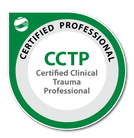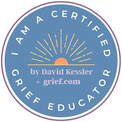|
“Death is a challenge. It tells us not to waste time… It tells us to tell each other right now that we love each other.” –Leo Buscaglia
This has been a challenging couple of weeks, as several families I know have had to deal with the death of a loved one. No matter what the circumstances, whether the individual was young or old, whether it was sudden or expected, death is not easy to face. Elisabeth Kübler-Ross’ famous book, On Death and Dying, explains various stages that people go through as part of the grieving process. She identified shock, denial, anger, depression, bargaining, and acceptance as stages that people progress through and noted that people may be in several stages simultaneously and may move back and forth between stages. In her book, she states, “It might be helpful if more people would talk about death and dying as an intrinsic part of life just as they do not hesitate to mention when someone is expecting a new baby.” In our society, death is a taboo subject. It is not something that is commonly talked about, yet it is inevitable for all of us to face. In some cultures death is a time for joyous celebration with songs and parades, in others the deceased is kept in the home for several days after death before the burial or cremation. Buddhism actually encourages people to think about death as a constant companion, like their shadow. Although it sounds morbid, there is something special that happens when we are forced to deal with death. Suddenly all of our daily problems seem small in comparison and expressing love seems much more important. There is a shift in how we view the world when we are faced with the reality that we are not guaranteed tomorrow. We begin to think about what we would miss most about life and we make those things our priority. We have all been given a terminal diagnosis: it is called birth. While we all know this, it is something that most of us don’t like to think about. Our denial of the inevitable causes us to put off doing things for another day but, if we knew that this was our last day, what would the priority be? A hospice nurse once told me that the biggest thing she learned from sitting with people in their last days was that most people talked about their regrets for the things they didn’t do when they had the opportunity. While it is often hard to find meaning in death, there is a gift; it awakens us to life.
0 Comments
“Inside each of us, there is the seed of both good and evil. It’s a constant struggle as to which one will win. And one cannot exist without the other.” –Eric Burdon
I have always known that there were different aspects of myself that I chose to allow others to see. Growing up I was a ‘good girl’ in school. I took on the role of the shy kid in class who didn’t dare to get into trouble. When I came home though, it was a different story. Throughout our lives different characters take center stage depending on what situation we are in. I am a different person when I’m talking to my boss then I am when I am talking to my son. Several theories of counseling talk about internal characters or parts of us that gain control. I like to think about it as a cast of characters who perform and take center stage at different points throughout the day. Some of the characters are shadowy aspects of ourselves, others are ones we like. While we need all of the characters, if the character on stage is in alignment with our authentic self, we feel good but, when it is out of alignment, we feel disconnected and disappointed with ourselves. The important thing about this analogy is that we are not any of the characters that are on the stage; we are the director behind the scenes. Many of us were never taught that we get to control which character goes on stage at what time. Most of us simply react to situations and the parts get to choose for themselves which ones go on stage. Sometimes we are happy with the part that stepped up to center stage, other times we are embarrassed by it. When we realize that we are able to pause in a situation and internally choose which character to place on the stage we uncover a hidden power. When we realize that a dark part has been on center stage, then make a decision to pull that character off stage and replace it with a more authentic part, we begin to make different choices about life. When we are the director we are able to yell, ‘cut’ when a part has gotten out of control. Are you ready to sit in the director’s chair? “Comfort in expressing your emotions will allow you to share the best of yourself with others, but not being able to control your emotions will reveal your worst.”- Bryant H. McGill
What is the difference between a thermometer and a thermostat? A thermometer is a tool which displays the temperature of the environment it is in. It simply reflects the air temperature around it. A thermostat on the other hand, regulates the environment. When a temperature is set it will turn up or down the heat to keep the air temperature it controls stable. A thermometer reacts to the environment, a thermostat controls the environment. This a critical difference. In life, many of us have never been taught that we actually have a thermostat to control our emotions. We live believing we only have a thermometer. When something happens we get angry. We believe we can’t control the anger, it just comes up from within us. Many people live believing that they are at the mercy of their emotions and the outside circumstances determine how they feel. When a car cuts them off in traffic, they immediately respond with anger. There is yelling, cursing and maybe even some gestures. When the thermometer reads danger or fear they simply react to the circumstance with whatever emotion comes up. What if we forced ourselves to look at that situation differently? Instead of telling the story about how the driver in the other car is inconsiderate and doesn’t know how to drive, how would their emotion shift if they found out the person in the car was on their way to the hospital after getting a call that their child was just in a serious accident? Instead of having rage toward the other driver, there would be compassion. In life there are many circumstances and events that we don’t have any control over. We do, however have complete control over how we respond to those events. When we take responsibility for setting our thermostats and monitoring when the thermostat is out of control we begin to live our lives differently. There is a difference between experiencing an emotion and becoming an emotion. Whenever you notice your thermometer reading an extreme temperature, take a moment to push pause and become curious about your choice of how to respond to the situation. Simply taking a few deep breaths in the moment can help to regulate the temperature and make it a more comfortable space for everyone. “The man who has no imagination has no wings.” — Muhammad Ali
As we look at the world we take in information through our five senses. From the time we are born we see, hear, smell, taste and touch to gain an understanding of our surroundings. While all animals also have five senses, we as humans are able to do something special with the information we receive. Through evolution, we have developed a part of our brain which allows us to process information and not just react to our situation, but to actually imagine what could happen and make choices. To take information in through our five senses gives us knowledge, but that knowledge is limited without an imagination to see the hidden possibilities. Albert Einstein said, “The true sign of intelligence is not knowledge but imagination.” This is powerful! As a former teacher I know that we focus a lot of time in schools drilling knowledge into our children. There is a set curriculum and standards that children are expected to meet. We give them tests to make sure that they have adequate knowledge. Since the scores on those tests are important to the district a large portion of time is spent making sure the kids are prepared with enough knowledge to pass. When do we ever test for imagination? When kids daydream they are scolded and told to focus on the knowledge that is being presented. While there are a few classes like art and music where kids are encouraged to use their imagination, the time is limited. When we think about everything that has been created in the world, it was first a thought in someone’s imagination before it became a thing. Edison imagined creating a system of illumination before the light bulb was invented. Walt Disney imagined a mouse before a cartoon was developed. The inventors of the chair, fork, toothbrush and every other item we use first had a thought and imagined it before they set out to create it. We are at a critical point in our human history. There are problems we are facing which knowledge cannot solve. What we need now is imagination. Many people think they don’t have a good imagination, but they do just fine at imagining everything that can go wrong. What would happen if we all took some time to imagine what could go right–to imagine a world we would love to live in? What if we imagined political parties and countries working together and solving problems that once seemed impossible? What if we imagine solutions for energy, the economy, education and violence? What kind of world could we create if we all imagine a world of peace? Maybe it is time to find out…. |
Archives
April 2020
Categories
All
|
 RSS Feed
RSS Feed




